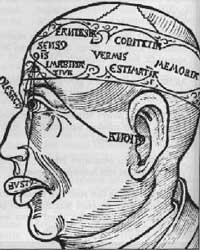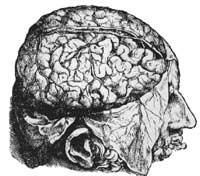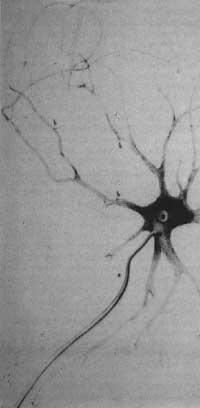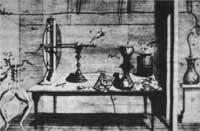By brain decade
The Congress of the United States has taken the decision to designate the decade of the brain for this decade of the 90's. We would like to note that: In the line that the evolution of science has addressed, extending human knowledge, one of the most worrying lagoons that appears today is the operation of this small and half kilometer hidden in our mind.

In addition, the denomination of cerebral decade shows the hope that the development of the new paths and techniques carried out so far will allow, in the coming years, all the efforts made to date are uncovered in the mystery that has been insufficient. Finally, this type of institutional recognition will have consequences to obtain the money necessary to promote these investigations and soon we will be able to see how congresses, meetings and publications on the subject multiply.
Faced with this situation, it seems appropriate, as has already been said, to expand at least one supervision to this field of knowledge in the stack: the brain and its function.
Historical perspective Historical perspective
It could be thought that, since man became aware of himself, he would realize the extraordinary importance of the brain in its form of being. The lifestyle they carried in prehistoric times caused cranial traumatisms and their consequences could not be hidden, could be seen and asked themselves. Moreover, in the deposits it has been discovered that several skulls dominated the technique of trepanation since remote times.
The first known genius on this subject is Egyptian and a. C. C. It seems made around the year 3000. It describes a series of wounds in the head and its symptoms, appearing paralysis of legs and arms, seizures or personality alterations. However, the Egyptians do not seem to understand the importance of the brain. For them, as for the Mesopotamian, Hebroan, and Greek cousins, the heart was the source of life, the place of mind, and feelings.
The pre-Socrats approached the current approaches in a broad and profound reflection on the world. On the one hand, the physical and psychic areas joined the same substance: first on earth, air, water and fire, and then on the atoms of Leucypus and Democritus. On the other hand, differentiating the different affective and intellectual functions, placing each of them in a certain part of the body.
For democrites, for example, the brain is the guardian of thought and mind, and he has the main ties of the soul, although the queen of anger and nodriza are the heart and the house of desire. These theses were developed with Plato. For him the main function was the intelligence found in the brain, which was immortal and was associated with the other two through the spinal cord. The cephalocentrist thesis was founded.
Aristotle, a teacher in several things, did not come to this end and promoted cardiocentrist theses. The role attributed to the brain is curious: it was formed by earth and water, and would be to cool the body. By the strength of his philosophy, this error persisted in official thought. However, the Greek doctors, following the line of Hippocrates and without paying much attention to cardiocentrism, began to study by becoming aware of the importance of the brain and began to perform prohibited dissections until then in Alexandria, Athens relief.
They distinguished between brain, brain and marrow and intracranial ventricles. Later, Galen, experimenting with the animal nervous system, showed that the control of the body and all the aspect of the mind are found in the brain and that its origin should be sought in the same brain substance. Although it seems that these clarifications should put the definitive limit to cardientrism, it was not so and by the hand of the medieval scholastic XVIII. Aristotelian ideas remained, in some way, until the nineteenth century.

Galeno has two other important contributions. On the one hand, divide the soul or mind into different functions. Mobility, sensitivity and reason, and in this reasonable soul, functions were imagination, reason and memory. On the other hand, he tells us about the substance of these functions. He is called psychic neum and circulating through the nerves unites the brain, movement and viscera of sensations.
In the Middle Ages not much was advanced, except that the philosophers of the Church, Nemesio and Augustine, above all, placed the three faculties of reason in the three ventricles of the brain. During the Renaissance, animal and body dissections multiplied and, at least with regard to the macroscopic structure, they came to know the brain anatomically completely. The beautiful prints made by Leonardo himself are not ashamed of those that could be made today. It was known, therefore, how the brain was, but little of the processes of execution of its capacities.
The forces that then crossed the nervous structures were called animal spirit and the controversy that has lasted until today was triggered: Is there anything that, apart from the brain, guides our desires (the soul, which depends on the physical characteristics of matter) or our higher psychic functions can be understood without the need to seek metaphysical information about the mere function of the brain? The followers of the first idea (dualists) and the second (monists) have exercised intense ideological competition and their courage has also been paid.
Descartes was a dualist. For him the body is a machine, but unlike animals, man has soul, unique, immortal and without matter. The problem is where and how that soul and body machine have joined. His solution was to place this link in the epicsis, arguing that it is the only simple structure of the brain (as the soul is also simple). Others would distinguish other places in the brain. Finally, the monists claimed the lack of soul to understand psychic functions and a Cabanis, for example, wrote: The brain flows the thought, as the liver bile.
XIX. At the beginning of the century, with the secularization of science and freedom of thought that opened after the French revolution, came the new theory of the mind of great prestige: Frenology of Galls. This anatomist highlighted the importance of the cerebral cortex. Distinguishing between grey and white, he discovered the anatomical unit of surface grey matter and its superior category. Gall was a monist, materialist, and on that surface he wanted to place the moral and intellectual capacities of man.
He separated 27 of them and tried to find a place in the bark. As a method, measuring skulls of sages, criminals and patients with mania, he proposed the relationship between continent (skull) and content (bark). Cranioscopy spread throughout the west, becoming a social phenomenon and causing considerable abuse. This bad match has concealed the direct intuitions of Galls for the future, which had the function of placing in the cortex.
The location fluctuations ended in 1861 thanks to Broca. In that year, this French neurologist clearly showed that the aphasia or loss of language through what was discovered in the autopsy was a consequence of an injury of the frontal lobe, so this superior function, the language, was placed in a place of the surface of the brain. From there, other locations were released through clinical resources and, finally, in 1908, Brod-mann carried out the bark map currently accepted.
For the realization of this map, Brodmann took into account the microscopic structure of cortex. In fact, years earlier, the technical problems that impeded the study of nervous tissue found a solution thanks to Golgi's dyeing forms. Although its macroscopic morphology was described for a long time, the internal structure of the brain was unknown, on the one hand due to the scarce development of microscopy and, on the other, due to the lack of mastery of the hardening and dyeing techniques of tissue.

XIX. At the end of the twentieth century, overcoming these obstacles, it was discovered that the nervous tissue, like the rest, was formed by cells. The microscopic anatomy of the brain begins and here we must mention Ramón y Cajal. His work showed the existence of different types of cells in brain tissue, among which are neurons, simple and in contact. He was not the first to identify cells, he had done so in 1865, but he did in his descriptions and received the Nobel Prize in 1906 with Golgam.
The internal structure of the brain and all the nervous tissue, as has happened in other viscera, could be thought to be close to understanding its functioning. It has not been so for several reasons. Galen's neum would wait until it developed physics and electricity within it. Galvani would, in 1786, relate for the first time the electrical force with the muscular contraction of the frog. His proposal is that animal spirits are ultimately electricity.
After numerous discussions this identification was verified in 1870, when the Germans Fritsch and Hitzig showed that the electric currents applied in the dog's brain generated movements in the animal and five years later the English Caton made the first electrophysiological record through the electrodes located on the surface of the rabbit's brain. The cells that form the brain, therefore, generate electricity and through it the different parts are communicated.
This model left some questions unanswered. For example, what happened when the nerves ended to influence the muscles, for example. Soon they realized that in these places the nervous termination secreted chemical substances and well embedded in our century, we have seen that these special chemical substances, the neurotransmitters, constitute the communication between the neurons through the bridge of the electric force.
After a long and varied path we have been able to know, on the one hand, the morphological and functional unit that constitutes the internal structure of the brain (nerve cell or neuron) and on the other, the type of energy that is the root of the physiological dynamics of the brain: the electrochemistry. To achieve this they have had to be developed by different disciplines: neuroanatomy, electrophysiology, neurological and psychiatric clinics, neurochemistry, experimental psychology, etc.
Aware of the need for the collaboration of these branches, at present the new name is used to express the unity of all: neuroscience. And these have more and more relation with other types of knowledge, such as philosophy, linguistics or artificial intelligence.
Evolution of neurosciences
Two are the ways to follow through neurosciences to advance. One down, from the neuron to the molecules; it can only be resolved by understanding physico-chemical interactions between the molecules that form the proper functioning of the nerve cell. The other up, from a single neuron to the psychic entities that are formed of groups, circuits, networks and neuronal groups. What are they and how does the brain perform sensations, movements, memories, dreams, thoughts, language, will, love, hatred or personal consciousness? And finally, when any of these functions get sick, how sick and what would be your remedy?
From the neuron to the molecule

Two are the factors that make it possible to advance this path: on the one hand, the development of physical-chemical techniques and on the other, the search or creation of suitable biological models. This path does not pose epistemological problems. It is difficult because resources at the molecular level require a great technical sophistication, but in recent years much has been advanced and the reasons to be optimistic of the future are solid.
We have mentioned the biological models, among which is the presence of electric organ fish, a large neuron of the chipiron or a marine hare called aplysis. Using our techniques in these models that nature has offered us, we have been able to know many things. For example, the electricity of neurons is produced by the different concentration of electrolytes between the internal and external parts of the cell, while the ions of sodium, potassium, calcium magnesium and other ions enter and leave in the neuron depending on the opening of channels in the membrane. Electrophysiology, from that common Brass record, has come to measure and analyze what occurs within the membrane of the neuron in just a hundred years.
Nature, especially the vegetable world, offers us substances that affect brain chemistry (psychotropic drugs) and man has synthesized in the laboratory during the last decades. Analyzing their mode of action have known brain neurotransmitters, their pathways of synthesis, their metabolism, their receptors, etc. These substances pass information between the two neurons and the place where it is produced is synapsis.
From the acetylcholine that was isolated at the beginning of the century to the peptides that have been found in recent years, we know a lot of neurotransmitters that will probably appear more in the coming years. The functioning of all will be better understood. To become aware of the importance of this, it is enough to think that almost all the psycho-drugs we currently have act on one or another neurotransmitter.
But both in the case of the electrical phenomena of the membrane and in the study of the metabolism of neurotransmitters, the looks are deepening today. The ionic protein channels to the enormous development of molecular biology, the enzymes for the synthesis of neurotransmitters or their receptors can be investigated in a genetic code that is a pre-formal reality. At this level there are great expectations of understanding and healing of diseases.
From the neuron to psychology
This path has flashy barriers and special problems. In the first place, and at least as regards the high level psychic functions of the human being, the lack of model. Although our neurons of the brain are similar to those of the marine hare, the properties of one of them can be investigated in the other, the language, the thought or the autoscience that arises from all our neurons is not found anywhere else and the only good model should be man.
Consequently, and for obvious ethical reasons, we can not use any technique other than anywhere and until recently we did not know it. Therefore, the sources of knowledge have been limited. On the one hand, since it was studied in animals, extrapolations were made and, on the other, in the clinic, consequences were extracted from the brain lesions and diseases that were inevitably produced. Being these two rather arid sources, it has given rise to theoretical speculation, and from there have emerged proposals or schools as diverse as those found to understand the psyche.
From the reflexology of Pavlov to the conductism or metapsychology of Freud, these mentalities have made their contributions to understand the normal and pathological psyche and, in passing, have alleviated many sufferings. But they have not elaborated a contrastable theory of the functioning of the psychic apparatus.

Among these schools there are those who describe as absurd the path that want to follow the neurosciences, the electrochemical phenomena that occur in the brain and that between our will no bridge can be extended. Science will not allow limits to reason, but it must be recognized that the position of the neuroscientist when he is studying high level psychic processes is really two birds.
When the reason wants to know what the reason is, the object and the subject merge. Someone has compared this situation to someone who wants to pull his pants down the ground. However, deciding whether knowledge has insurmountable limits is a philosophical problem. While the problem is solved, science is moving away from those limits and, in passing, expanding the field of knowledge.
If there is a right to think that in the coming years there will be decisive advances in neuroscience. And this hope is based, among other things, on the preparation of techniques for the study of the psychic activity of the human being. We will mention two of them, the evoked potentials and the so-called positron cameras.
The evoked potentials have the same base as electroencephalography: receive the electrical activity of the brain by electrodes placed on the surface of the head. It does not produce, therefore, any damage. Any stimulus when reaching the brain produces a small change, although its observation is impossible in a normal EEG, since background noise covers weak signals. The technique of the evoked potentials allows the computer, when treating the information, to present these small signals and show the wave caused by the stimulus, imputing all the others. Evoked wave, in which a very attentive person can see where, when and how it appears in any psychic action.
The same idea, that is, to know the changes of state of the brain in a mental process, is at the base of the positron chamber. But the technique is very different and instead of measuring electrical activity, it perceives metabolic changes. For this purpose, isotopes that release positrons are needed.
For their short life, they can be used in humans with total security. Physiological substances, glucose a.b., or psycho-drugs with isotopes such as carbon lis may be marked. The positron chamber follows the kinetic and distribution of the marked theme and a computer places the observed radioactivity in the images. In this way, the consumption of oxygen or glucose can be measured in a certain part of the brain and its changes in the different psychic activities. A dynamic image of the brain is obtained showing different levels of activity.
These two techniques are not the only ones we mentioned, but those that generate the most expectations in their beginnings. The existing paths and, undoubtedly, those that will be prepared in the coming years will incite in the physiology of the psychic processes that until now has remained so dark and in the functioning of the brain. Therefore, those of us who are interested in these things have to be attentive during this decade', in the decade of the brain.





